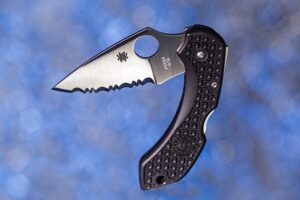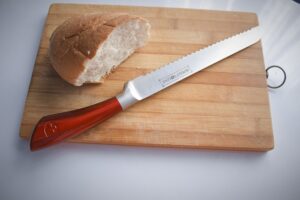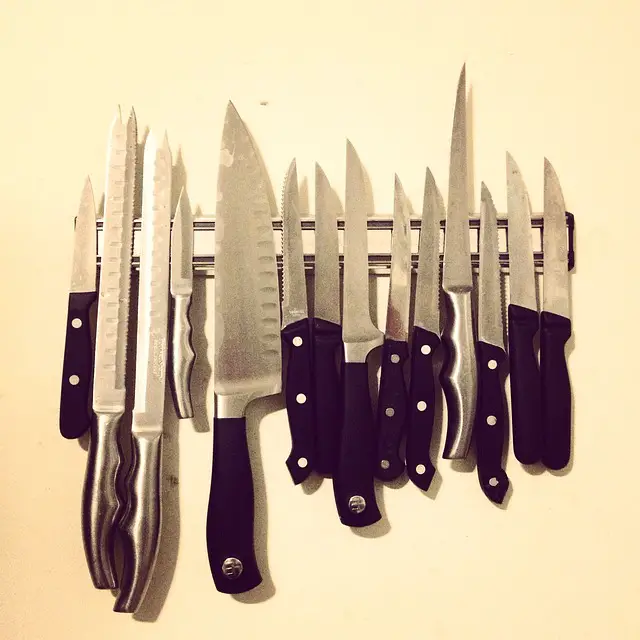Welcome to our comprehensive guide on understanding the different types of knife blades. Whether you’re a culinary enthusiast, a professional chef, or simply someone who appreciates a good kitchen tool, knowing the intricacies of knife blades can greatly enhance your cooking experience.
In this article, we will demystify the world of knife blades by breaking down the various types and their unique characteristics. From the versatile chef’s knife to the precise boning knife, we’ll explore the distinct purposes each blade serves and how they can elevate your culinary creations.
We’ll delve into the pros and cons of stainless steel, carbon steel, and ceramic blades, highlighting their differences in terms of sharpness, durability, and maintenance. We’ll also discuss blade thickness, edge geometry, and other factors that impact performance and longevity.
Whether you’re in the market for a new knife or simply seeking to expand your knowledge, this guide will equip you with the essential information to make informed decisions and take your cooking skills to new heights. Get ready to slice, dice, and chop like a pro!
Common Types of Knife Blades
When it comes to knife blade types, there are various types to choose from, each with its own unique features and benefits. Understanding the different types will help you make an informed decision based on your specific needs and preferences.
Fixed blade knives
Fixed blade knives are the traditional choice for many professional chefs and outdoor enthusiasts. These knives have a solid, non-folding blade that is permanently attached to the handle. This construction provides exceptional strength and stability, making fixed blade knives a popular choice for heavy-duty tasks.
One of the key advantages of fixed blade knives is their reliability. Since there are no moving parts, they are less likely to fail in high-stress situations. They are commonly used for tasks such as hunting, camping, and survival situations. Fixed blade knives are also favored by many chefs for tasks that require precision and control, such as filleting fish or deboning poultry.
However, the downside to fixed blade knives is their lack of portability. Due to their larger size and the absence of a folding mechanism, they can be cumbersome to carry around. Additionally, they require a sheath or protective cover for safe storage and transportation. Despite these limitations, fixed blade knives remain a staple in many professional kitchens and outdoor settings.
Folding blade knives

Folding blade knives, also known as pocket knives, are a popular choice for everyday carry due to their compact and versatile nature. These knives have a hinge mechanism that allows the blade to fold into the handle, making them easy to store and carry.
The main advantage of folding blade knives is their portability. Their compact size and folding mechanism make them convenient for various tasks, from opening packages to cutting fruits and vegetables on the go. Many folding blade knives also offer additional tools, such as bottle openers, screwdrivers, and can openers, making them handy for a wide range of situations.
However, folding blade knives do have some limitations compared to their fixed blade counterparts. The folding mechanism introduces potential points of failure, and the blade may not be as sturdy as a fixed blade knife. This can affect the knife’s overall strength and durability, particularly during heavy-duty tasks. Despite these limitations, folding blade knives are a popular choice for everyday carry and general-purpose use.
Straight edge blades
Straight edge blades, as the name suggests, have a sharp, straight cutting edge. These blades are versatile and can be used for various cutting tasks, including slicing, dicing, and chopping. They are commonly found on chef’s knives, Santoku knives, and many other kitchen knives.
The main advantage of straight edge blades is their precision and control. The straight cutting edge allows for clean and precise cuts, making them ideal for tasks that require accuracy, such as mincing herbs or slicing delicate ingredients. Straight edge blades also make it easier to maintain a consistent cutting angle, resulting in more even slices.
However, straight edge blades may not be suitable for all types of ingredients. Some foods, such as crusty bread or tough-skinned fruits, may require a serrated edge for optimal performance. Additionally, straight edge blades may require more maintenance to keep them sharp, as they are prone to dulling over time. Regular honing and sharpening are essential to ensure optimal cutting performance.
Serrated edge blades

Serrated edge blades, also known as saw-toothed blades, feature a series of small, scalloped teeth along the cutting edge. These blades are designed to grip and tear through tough or fibrous materials with ease. Serrated edge blades are commonly found on bread knives, steak knives, and some utility knives.
The main advantage of serrated edge blades is their ability to cut through tough or crusty surfaces. The serrations act as miniature saw teeth, allowing the blade to grip and tear through the outer layer of the food, while the sharp edge slices through the softer interior. This makes serrated edge blades ideal for tasks such as slicing bread, tomatoes, or tough-skinned fruits.
However, serrated edge blades may not be suitable for tasks that require precise and clean cuts. The serrations can leave behind a rougher edge and may cause tearing or crushing of delicate ingredients. Additionally, sharpening serrated edge blades can be more challenging compared to straight edge blades. Specialized sharpening tools or professional sharpening services are often required to maintain the serrations’ integrity.
Some knife blades feature a combination of both straight and serrated edges. These blades are known as partially serrated blades and offer the best of both worlds. The straight edge section is ideal for tasks that require clean, precise cuts, while the serrated section excels at cutting through tough or fibrous materials.
The advantage of partially serrated blades is their versatility. They can handle a wide range of cutting tasks, from slicing bread to preparing vegetables or meat. The straight edge section is suitable for tasks that require precision, while the serrated section can tackle tougher materials with ease.
However, partially serrated blades may not be the best choice for all situations. The combination of both edge types can make sharpening more challenging, as specialized sharpening tools are often required to maintain both sections’ integrity. Additionally, the transition between the straight and serrated sections may affect the overall cutting experience, requiring some adjustment.
Hollow ground blades
Hollow ground blades have a concave grind along the cutting edge, creating a thin, sharp edge that excels in slicing tasks. This type of blade is commonly found on chef’s knives, carving knives, and some utility knives.
The main advantage of hollow ground blades is their exceptional slicing performance. The concave grind reduces the surface area in contact with the food, resulting in less friction and smoother cutting. This makes hollow ground blades ideal for tasks that require precise and effortless slicing, such as carving roasts or slicing delicate ingredients like fish or sushi.
However, hollow ground blades may not be as suitable for tasks that require more robust cutting or chopping. The thin edge can be more prone to chipping or damage when used on harder or denser materials. Additionally, hollow ground blades may require more frequent sharpening to maintain their optimal cutting performance.
Both blades
Both blades, also known as double-edged blades, have a sharp cutting edge on both sides of the blade. These blades are commonly seen in Japanese-style knives, such as the Santoku and Nakiri. The double-edged design offers versatility and allows for precise and delicate cuts. However, they require additional care and skill to avoid accidental injuries.
Drop point blades
Drop point blades have a convex curve along the cutting edge, creating a strong and versatile blade shape. This type of blade is commonly found on hunting knives, survival knives, and many everyday carry knives.
The main advantage of drop point blades is their versatility and strength. The curved cutting edge provides a large belly, making it ideal for tasks that require slicing or skinning. The strong, robust tip is also suitable for piercing or thrusting, making drop point blades a popular choice for outdoor activities and self-defense.
However, the drop point blade’s versatility may come at the expense of some specialized cutting tasks. The larger belly and less acute point may not be as suitable for tasks that require fine or delicate cuts. Additionally, the drop point blade’s shape may affect overall control and maneuverability, particularly for intricate cutting techniques.
Tips for choosing from the different types of knife blades
In conclusion, understanding the different types of knife blades is crucial for selecting the right tool for your culinary needs. Consider factors such as the type of tasks you’ll be performing, the materials used in the blade, and your personal preferences for maintenance and sharpening.
When choosing a knife blade, it’s important to strike a balance between durability, sharpness, and ease of maintenance. Stainless steel blades are known for their resistance to corrosion, while carbon steel blades offer superior sharpness. Ceramic blades are extremely sharp and require less maintenance, but they are more fragile and can chip or break if not handled with care.
Additionally, consider the shape of the blade and its intended use. Straight edge blades are versatile and suitable for a wide range of tasks, while serrated edge blades excel at cutting through tough or crusty items. Hollow ground blades are ideal for slicing, while both blades offer precision and delicate cuts. Drop point blades are versatile and suitable for various tasks, especially in outdoor settings.
Ultimately, the right knife blade will depend on your individual needs and preferences. Investing in a high-quality knife with the right blade type can greatly enhance your cooking experience and make meal preparation a breeze. So, take your time to research, try out different types, and choose the blade that feels comfortable and efficient in your hand.
With this comprehensive guide, you now have the knowledge to make informed decisions and take your cooking skills to new heights. Whether you’re a professional chef or a home cook, understanding the different types of knife blades will undoubtedly elevate your culinary creations. Happy cooking!




